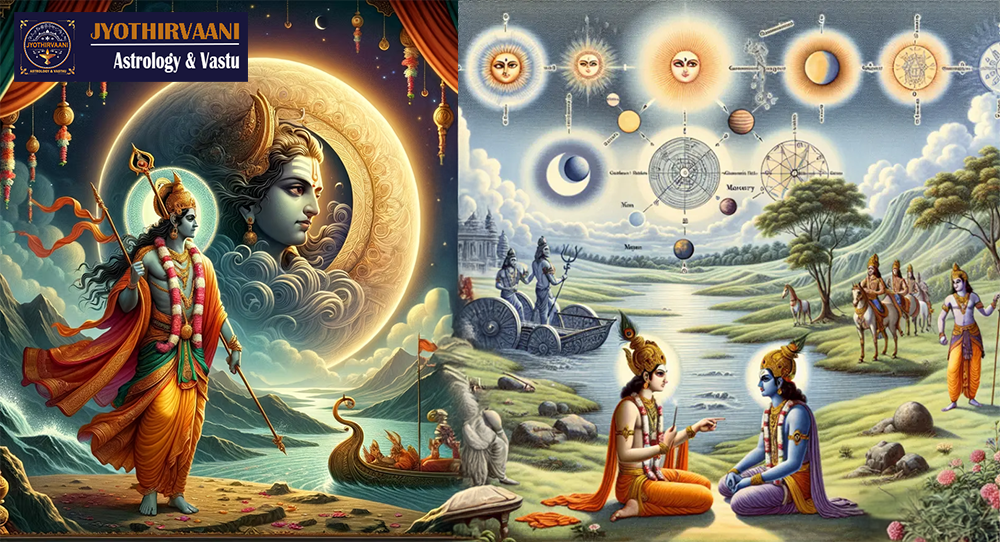Yogas in Vedic Astrology
Indicators of Wealth, Wisdom & Spiritual Growth
In the sacred tradition of Sanatana Dharma, the universe is not merely a physical phenomenon but a conscious, divine order—Rta—reflected in every soul. Jyotisha Shastra, the eye of the Vedas, reveals how this cosmic intelligence manifests uniquely in each individual through Yogas—planetary combinations that shape our journey through karma, dharma, and moksha.
Wealth Yogas: The Grace of Lakshmi
In Vedic astrology, wealth is not just material prosperity but the flow of divine grace. Yogas such as Dhana Yoga, Lakshmi Yoga, and Chandra-Mangal Yoga indicate the presence of this abundance.
Dhanaṁ me jyotiṣāṁ patiḥ prajāpatiḥ prāyacchatu.
May the Lord of Jyotiṣa, Prajāpati, bestow wealth upon me.
— Taittirīya Āraṇyaka, Kṛṣṇa Yajurveda
Dhana Yoga forms when the lords of the 2nd and 11th houses (wealth and gains) are well-placed and connected with benefic planets. Lakṣmī Yoga arises when the lord of the 9th house (fortune) is exalted and placed in a Kendra or Trikoṇa with the ascendant lord, signifying earned blessings from past lives.
These Yogas reflect puṇya karma—the fruits of righteous actions—and often activate during favorable daśā periods, aligning with the soul’s karmic timeline.
Wisdom Yogas: The Light of Sarasvatī
Wisdom in Jyotiṣa is the unfolding of Jñāna Śakti, the power of divine knowledge. Yogas like Budha-Āditya Yoga, Gaja-Kesarī Yoga, and Sarasvatī Yoga indicate intellectual brilliance and spiritual insight.
Satyaṁ jñānaṁ anantaṁ brahma.
Truth, knowledge, and infinity—that is Brahman.
— Taittirīya Upaniṣad, Kṛṣṇa Yajurveda
Sarasvatī Yoga is formed when Budha (Mercury), Guru (Jupiter), and Śukra (Venus) are strong and well-placed in Kendra or Trikoṇa houses. This Yoga blesses the native with eloquence, scriptural understanding, and refined intellect—qualities essential for a Jyotiṣī, a seeker of cosmic truth.
Gaja-Kesarī Yoga, formed by the Moon and Jupiter in mutual Kendra, bestows not only intelligence but also dharma-aligned thinking, guiding the native toward righteous action.
Spiritual Yogas: The Path to Liberation
The highest aim of Jyotiṣa is not prediction but liberation. Yogas such as Parivrāja Yoga, Mokṣa Yoga, and Mahābhāgya Yoga indicate a soul inclined toward renunciation, spiritual practice, and freedom from the cycle of birth and death.
Yadā paśyaḥ paśyate rukma-varṇaṁ kartāram īśaṁ puruṣaṁ brahma-yonim.
When the seer sees the golden-hued Creator, the Puruṣa, the source of Brahman…
— Śvetāśvatara Upaniṣad
Parivrāja Yoga arises when four or more planets occupy Kendra houses, especially involving Śani (Saturn) and Guru (Jupiter), indicating a renunciate or spiritual teacher. Mokṣa Yogas often involve the 4th, 8th, and 12th houses—domains of inner transformation, hidden wisdom, and liberation.
The Kṛṣṇa Yajurveda emphasizes antar-yajña—the inner sacrifice of ego, desire, and ignorance. These Yogas reflect the soul’s readiness to transcend worldly attachments and seek Ātma-Jñāna, the knowledge of the Self.
Conclusion: Jyotiṣa as a Sacred Mirror
For Śrī Śarath Chandra Sharma, whose spiritual lineage flows through Śrī Veda Gāyatrī Jyotiṣālayam, these Yogas are not theoretical—they are living truths. They reflect the cosmic rhythm of Sanātana Dharma and serve as tools for guiding seekers toward wealth, wisdom, and liberation.
Yathā piṇḍe tathā brahmāṇḍe.
As is the microcosm, so is the macrocosm.
May the sacred science of Jyotiṣa continue to illuminate the path of dharma, under the divine guidance of the Jyotir Vidyā, the eternal light of wisdom.



